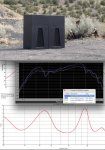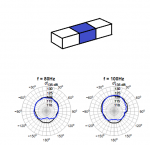Re: Article: Stair Cardioid
The measurement mic was on axis on the ground 2 meters from the mouth of one sub. The mic position remained in the same position when the "dummy" (unpowered, then shorted) sub was put in place along side.
The effect of the second sub is apparent in both near and far field measurements, though on my property there are some building reflections that make the 2 meter measurements more indicative of the actual response.
The resonant effects of the non terminated sub correspond with the impedance curve, being a tapped horn there is a secondary impedance peak evident around 100 Hz that causes a corresponding frequency response dip similar to the one around 45 Hz. A bass reflex enclosure would likely only have one dip in response in the pass band.
I will look forward to your new measurements, as another data point it would be interesting to compare the results with the obstacle cabinet shorted compared to connected to a turned on amplifier, no doubt the three different measurements (open, shorted, connected to turned on power amp) will be recognizably different.
Art
Sebastian,So the turned off acts like a resonator, or pasive device. In this case the obstacle box was not conected, and not shorted. So new measurements are required.
On the measurement you showed, where was the mic located ? Is that a local effect near to the obstacle sub, or a general change in the farfield ?
The measurement mic was on axis on the ground 2 meters from the mouth of one sub. The mic position remained in the same position when the "dummy" (unpowered, then shorted) sub was put in place along side.
The effect of the second sub is apparent in both near and far field measurements, though on my property there are some building reflections that make the 2 meter measurements more indicative of the actual response.
The resonant effects of the non terminated sub correspond with the impedance curve, being a tapped horn there is a secondary impedance peak evident around 100 Hz that causes a corresponding frequency response dip similar to the one around 45 Hz. A bass reflex enclosure would likely only have one dip in response in the pass band.
I will look forward to your new measurements, as another data point it would be interesting to compare the results with the obstacle cabinet shorted compared to connected to a turned on amplifier, no doubt the three different measurements (open, shorted, connected to turned on power amp) will be recognizably different.
Art






